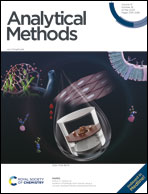Real-time monitoring of atmospheric ammonia based on modifier-enhanced vacuum ultraviolet photoionization ion mobility spectrometry†
Abstract
Ammonia (NH3) plays an important role in the atmospheric environment such as the formation of PM2.5, the concentration monitoring of which could hence help in the air quality assessment. In this study, a method for quantitative monitoring of atmospheric NH3 was developed based on modifier-enhanced selectivity detection using a homemade vacuum ultraviolet photoionization ion mobility spectrometry (VUV-PI-IMS). To enhance the resolution and sensitivity of measuring NH3, 2-butanone as the gas modifier was introduced into the drift tube with the drift gas. Atmospheric NH3 can be selectively detected, where the peak-to-peak resolution (RP-P) of 7.69 was obtained. The product ions were identified to be [C4H8O]2NH4+ by using a homemade time-of-flight mass spectrometer. The calculated limit of detection (LOD) was 0.39 ppbv improving about 10 times. For the most common concentration variation of atmospheric NH3 in the range of 10–100 ppbv, the linear curve was obtained with R2 of 0.997. Lastly, the VUV-PI-IMS was used to monitor the evolution of atmospheric NH3 near our laboratory and mounted on a car for monitoring the regional distribution of atmospheric NH3 in Dalian, China. The results also showed that VUV-PI-IMS has a promising application prospect in monitoring the concentration of atmospheric NH3 and supporting the air quality assessment.

- This article is part of the themed collection: Analytical Methods HOT Articles 2023


 Please wait while we load your content...
Please wait while we load your content...